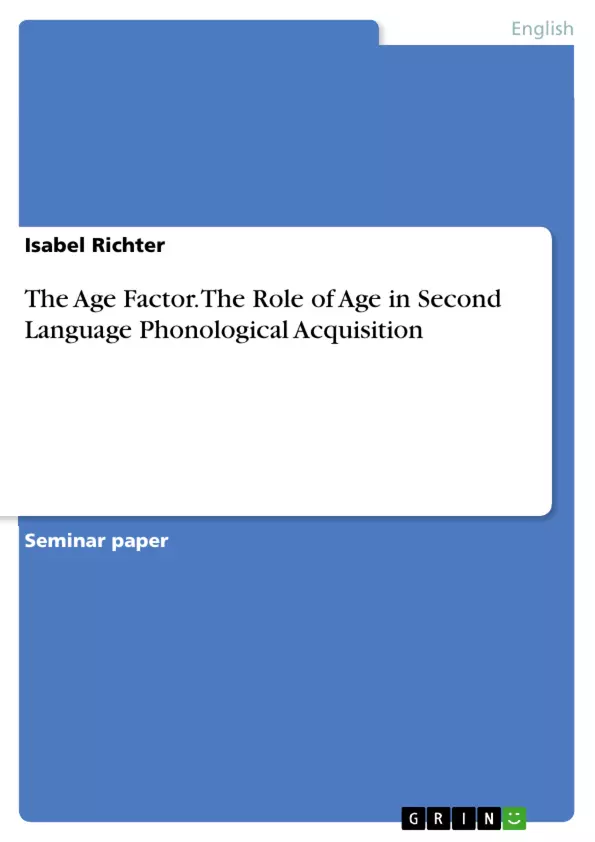In the first section, this research paper will present the role of age on L2 phonological acquisition by explaining the strong and weak version of the critical period hypothesis. Furthermore, it will give insight into important studies that either support or decline the opinion of age being a relevant factor for a native-like acquisition of a second language phonology. Subsequently, in the last section, it will be sketched to what extent other socio-motivational circumstances among L2 learners can cause individual differences throughout the acquisition of an L2 phonology. Both sections critically examine the relevance of the L2 learner’s age regarding the acquisition of an L2 phonology in order to find an answer to the question if age does affect the acquisition of a native-like pronunciation. As a last step, the main points and findings of this research paper will be summarised in the conclusion.
Inhaltsverzeichnis (Table of Contents)
- Introduction
- Age as a factor in second language phonological acquisition
- The critical and sensitive period hypothesis on second language acquisition
- Supportive studies vs. opposing views
- The controversy of the age factor
- Other influential factors in second language acquisition
- Conclusion
- References
Zielsetzung und Themenschwerpunkte (Objectives and Key Themes)
This research paper aims to explore the role of age in second language phonological acquisition, specifically focusing on the critical period hypothesis and its impact on achieving a native-like pronunciation. It examines both supportive and opposing perspectives on this hypothesis, analyzing studies that suggest age as a significant factor in acquiring an accent-free second language. The paper also considers other factors that might influence language acquisition, such as motivation and social circumstances.
- The Critical Period Hypothesis (CPH) and its implications for second language acquisition
- The role of age in achieving a native-like pronunciation in a second language
- The impact of various studies on the validity of the CPH
- The influence of socio-motivational factors on second language acquisition
- The complexities of the relationship between age and the acquisition of an L2 phonology
Zusammenfassung der Kapitel (Chapter Summaries)
- Introduction: The introductory chapter establishes the context for the research paper, highlighting the observation that adult L2 learners often struggle with foreign accents while young learners acquire fluency with greater ease. The chapter introduces the debate surrounding the critical period hypothesis and the influence of age on second language phonological acquisition.
- Age as a factor in second language phonological acquisition: This section delves into the critical period hypothesis, outlining both the strong and weak versions of the theory. The discussion highlights the debate on whether age is a determining factor in achieving a native-like pronunciation in a second language.
- The critical and sensitive period hypothesis on second language acquisition: This chapter examines the critical period hypothesis in detail, exploring the proposed time frame during which L2 learners can acquire native-like proficiency. The chapter discusses the strong and weak versions of the hypothesis, commonly referred to as the critical period and sensitive period, respectively.
- Supportive studies vs. opposing views: This section delves into specific studies that either support or challenge the existence of a critical period for second language acquisition. It explores evidence for and against the idea that age plays a significant role in achieving a native-like accent.
- The controversy of the age factor: This chapter examines the ongoing debate surrounding the impact of age on second language phonological acquisition. It explores the complexities of the relationship between age and the ability to acquire a native-like accent in a second language.
Schlüsselwörter (Keywords)
The main keywords and focus topics of this research paper revolve around the acquisition of second language phonology, specifically the influence of age on achieving a native-like pronunciation. Key terms include the critical period hypothesis (CPH), age of arrival (AOA), second language acquisition (L2A), and voice onset time (VOT). The paper investigates the impact of these factors on the acquisition of second language phonology, exploring both the supportive and opposing arguments surrounding the critical period hypothesis.
- Arbeit zitieren
- Isabel Richter (Autor:in), 2018, The Age Factor. The Role of Age in Second Language Phonological Acquisition, München, GRIN Verlag, https://www.hausarbeiten.de/document/510567


